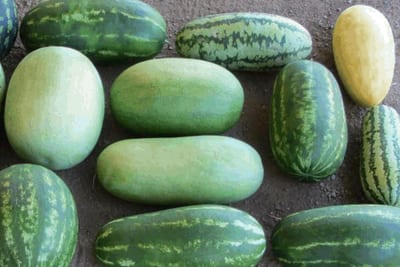News
Scientists Find Clues into More Disease-Resistant Watermelons, Genome Decoded
 Are juicier, sweeter, more disease-resistant watermelons on the way? An international consortium of more than 60 scientists from the United States, China and Europe has just published the genome sequence of watermelon (Citrullus lanatus), information that could dramatically accelerate watermelon breeding towards production of a more nutritious, tastier, and more resistant fruit. The watermelon genome sequence was published in the November 25th online version of the journal Nature Genetics.
Are juicier, sweeter, more disease-resistant watermelons on the way? An international consortium of more than 60 scientists from the United States, China and Europe has just published the genome sequence of watermelon (Citrullus lanatus), information that could dramatically accelerate watermelon breeding towards production of a more nutritious, tastier, and more resistant fruit. The watermelon genome sequence was published in the November 25th online version of the journal Nature Genetics.
The researchers discovered that a large portion of disease resistance genes were lost in the domestication of watermelon. With the high-quality watermelon sequence now complete, it is hoped that breeders can now use the information to recover some of these natural disease defenses.
The authors reported that the genome of the domesticated watermelon contained 23,440 genes, roughly the same number of genes as in humans. The group compared the genomes of 20 different watermelons and developed a first-generation genetic variation map (HapMap) for watermelon. This information allowed them to identify genomic regions that have been under human selection including those associated with fruit color, taste, and size.
“Watermelons are an important cash crop and among the top five most consumed fresh fruits; however, cultivated watermelons have a very narrow genetic base, which presents a major bottleneck to its breeding. Decoding the complete genome of the watermelon and resequencing watermelons from different subspecies provided a wealth of information and toolkits to facilitate research and breeding,” according to Zhangjun Fei, a scientist at the Boyce Thompson Institute for Plant Research (BTI) and one of the leaders of this project.
Fei worked with BTI scientists on different aspects of the research. James Giovannoni generated the gene expression data through RNA-sequencing and Lukas Mueller provided additional analysis to confirm the quality of the genome assembly. Fei also collaborated with Amnon Levi, a Research Geneticist at the USDA-ARS, U.S. Vegetable Laboratory, Charleston, SC, on genetic mapping and identifying candidate genes that might be useful to enhance disease resistance in watermelon. The genome sequences of the watermelon are publicly available at the Cucurbit Genomics Database (www.icugi.org), which is created and maintained by Fei’s group.
Believed to have originated in Africa, watermelons were cultivated by Egyptians over 4,000 years ago, where the fruit was a source of water in dry, desert conditions. They are now consumed throughout the world—with over 400 varieties in global commercial production. China leads in global production of the fruit, and the United States ranks fourth with over 40 states involved in the industry. Despite being over 90% water, watermelons do contain important nutrients like Vitamins A and C and lycopene, a compound that gives some fruits and vegetables their red color. A diet rich in lycopene appears to reduce the risk of certain types of cancer. Watermelon is also a natural source of citrulline, a non-essential amino acid with various health and athletic performance benefits.
Subscribe to BTI's LabNotes Newsletter!
Contact:
Boyce Thompson Institute
533 Tower Rd.
Ithaca, NY 14853
607.254.1234
contact@btiscience.org
Copyright © 2023 | Boyce Thompson Institute | All rights reserved | Privacy Policy | Cookie Policy


